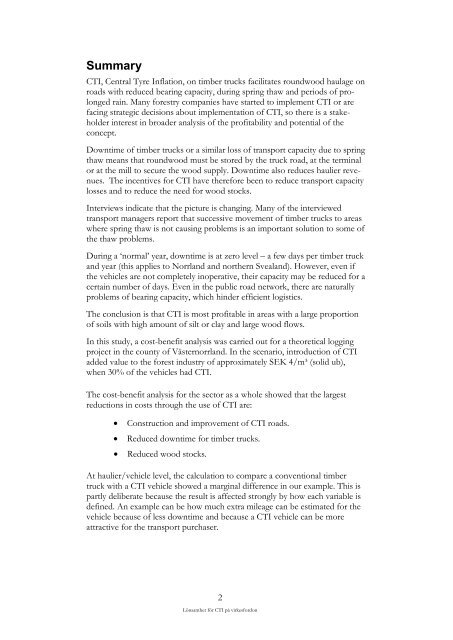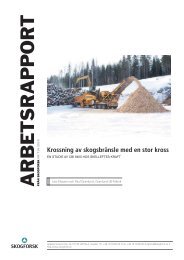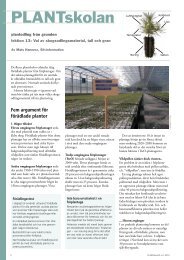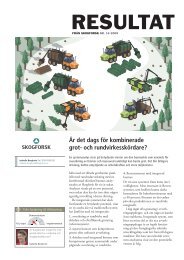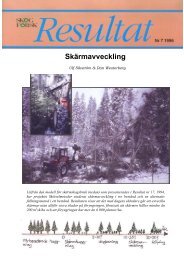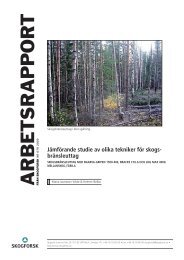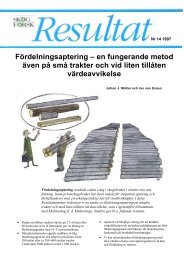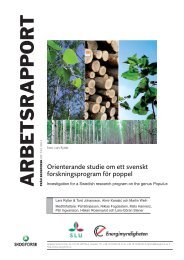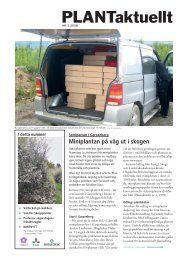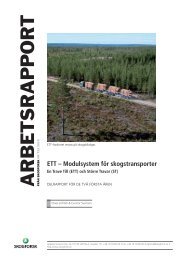Lönsamhet för CTI på virkesfordon - Skogforsk
Lönsamhet för CTI på virkesfordon - Skogforsk
Lönsamhet för CTI på virkesfordon - Skogforsk
You also want an ePaper? Increase the reach of your titles
YUMPU automatically turns print PDFs into web optimized ePapers that Google loves.
Summary<strong>CTI</strong>, Central Tyre Inflation, on timber trucks facilitates roundwood haulage onroads with reduced bearing capacity, during spring thaw and periods of prolongedrain. Many forestry companies have started to implement <strong>CTI</strong> or arefacing strategic decisions about implementation of <strong>CTI</strong>, so there is a stakeholderinterest in broader analysis of the profitability and potential of theconcept.Downtime of timber trucks or a similar loss of transport capacity due to springthaw means that roundwood must be stored by the truck road, at the terminalor at the mill to secure the wood supply. Downtime also reduces haulier revenues.The incentives for <strong>CTI</strong> have therefore been to reduce transport capacitylosses and to reduce the need for wood stocks.Interviews indicate that the picture is changing. Many of the interviewedtransport managers report that successive movement of timber trucks to areaswhere spring thaw is not causing problems is an important solution to some ofthe thaw problems.During a ‘normal’ year, downtime is at zero level – a few days per timber truckand year (this applies to Norrland and northern Svealand). However, even ifthe vehicles are not completely inoperative, their capacity may be reduced for acertain number of days. Even in the public road network, there are naturallyproblems of bearing capacity, which hinder efficient logistics.The conclusion is that <strong>CTI</strong> is most profitable in areas with a large proportionof soils with high amount of silt or clay and large wood flows.In this study, a cost-benefit analysis was carried out for a theoretical loggingproject in the county of Västernorrland. In the scenario, introduction of <strong>CTI</strong>added value to the forest industry of approximately SEK 4/m³ (solid ub),when 30% of the vehicles had <strong>CTI</strong>.The cost-benefit analysis for the sector as a whole showed that the largestreductions in costs through the use of <strong>CTI</strong> are:• Construction and improvement of <strong>CTI</strong> roads.• Reduced downtime for timber trucks.• Reduced wood stocks.At haulier/vehicle level, the calculation to compare a conventional timbertruck with a <strong>CTI</strong> vehicle showed a marginal difference in our example. This ispartly deliberate because the result is affected strongly by how each variable isdefined. An example can be how much extra mileage can be estimated for thevehicle because of less downtime and because a <strong>CTI</strong> vehicle can be moreattractive for the transport purchaser.2Lönsamhet för <strong>CTI</strong> på <strong>virkesfordon</strong>


